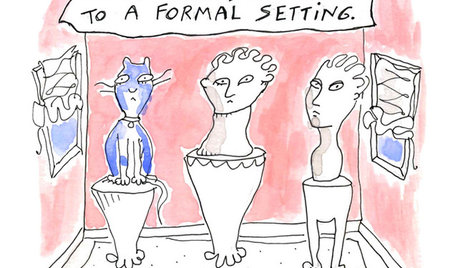So bummed out, my lawn is dying, please help
GrowSomeGrass
9 years ago
Related Stories

GARDENING GUIDES8 Unthirsty Plants Help You Save Water in Style
Spend less effort and money on your landscape with drought-tolerant and native plants that liven up your yard
Full Story
GARDENING GUIDESGreat Design Plant: Ceanothus Pleases With Nectar and Fragrant Blooms
West Coast natives: The blue flowers of drought-tolerant ceanothus draw the eye and help support local wildlife too
Full Story
DECORATING GUIDESPlease Touch: Texture Makes Rooms Spring to Life
Great design stimulates all the senses, including touch. Check out these great uses of texture, then let your fingers do the walking
Full Story
PETSHow to Help Your Dog Be a Good Neighbor
Good fences certainly help, but be sure to introduce your pup to the neighbors and check in from time to time
Full Story
MOST POPULAR7 Ways Cats Help You Decorate
Furry felines add to our decor in so many ways. These just scratch the surface
Full Story
DECLUTTERINGDownsizing Help: How to Get Rid of Your Extra Stuff
Sell, consign, donate? We walk you through the options so you can sail through scaling down
Full Story
MOST POPULAR9 Real Ways You Can Help After a House Fire
Suggestions from someone who lost her home to fire — and experienced the staggering generosity of community
Full Story
PETS6 Ways to Help Your Dog and Landscape Play Nicely Together
Keep your prized plantings intact and your dog happy too, with this wisdom from an expert gardener and dog guardian
Full Story
FRONT YARD IDEASBefore and After: Front Lawn to Prairie Garden
How they did it: Homeowners create a plan, stick to it and keep the neighbors (and wildlife) in mind
Full Story
FEEL-GOOD HOMEWhat Really Makes Us Happy at Home? Find Out From a New Houzz Survey
Great design has a powerful impact on our happiness in our homes. So do good cooking smells, family conversations and, yes, big-screen TVs
Full StoryMore Discussions








GrowSomeGrassOriginal Author
GrowSomeGrassOriginal Author
Related Professionals
Wrentham Landscape Architects & Landscape Designers · Folsom Landscape Architects & Landscape Designers · Saint Charles Landscape Architects & Landscape Designers · Allentown Landscape Contractors · Bethlehem Landscape Contractors · Broadlands Landscape Contractors · Cicero Landscape Contractors · La Verne Landscape Contractors · Little Ferry Landscape Contractors · Panama City Beach Landscape Contractors · Plantation Landscape Contractors · Stallings Landscape Contractors · Tigard Landscape Contractors · Wethersfield Landscape Contractors · Newman Swimming Pool BuildersGrowSomeGrassOriginal Author
dchall_san_antonio
GrowSomeGrassOriginal Author
lascatx
GrowSomeGrassOriginal Author
ahelaumakani
joneboy
greencarpet
danielj_2009
morpheuspa (6B/7A, E. PA)
GrowSomeGrassOriginal Author
GrowSomeGrassOriginal Author
morpheuspa (6B/7A, E. PA)
joneboy
GrowSomeGrassOriginal Author
GrowSomeGrassOriginal Author
morpheuspa (6B/7A, E. PA)
joneboy